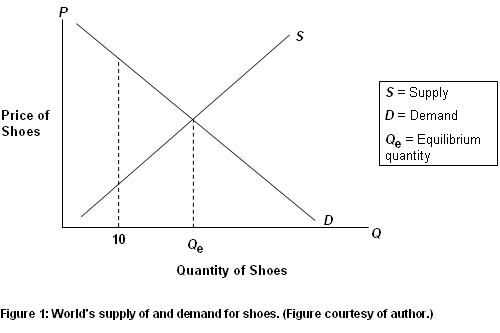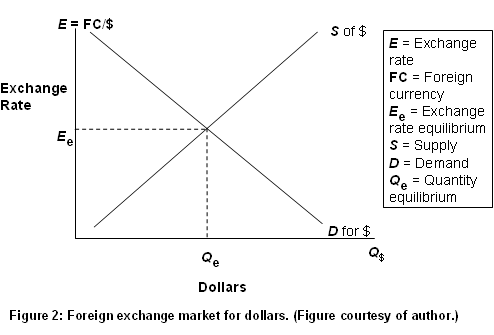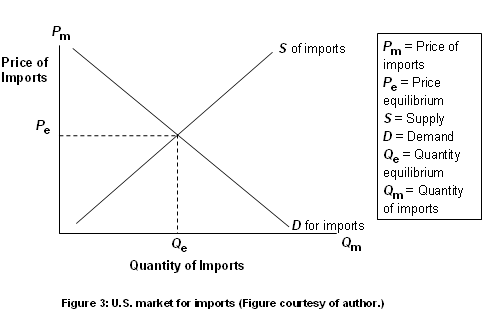International Economics and the AP Macroeconomics Course
Introduction
Although the AP Macroeconomics course introduces aspects of international economics relatively early in the course (when the principles of national income accounting and aggregate demand are introduced), teachers often leave the formal analysis of international transactions until the end. This tendency may be the reason why many students find the AP Exam questions relating to international economics to be the most difficult.
By showing students where international economic ideas fit into the course's initial, more elementary analyses, you can help them apply global concepts throughout the course and be better prepared for more formal analysis at the end of the term.
Beginning With Opportunity Cost
A natural point at which to introduce international economic ideas is when the text or syllabus reaches the topic of opportunity cost, which establishes the basis of comparative advantage and exchange. Adding a few relatively simple examples can easily make the point; the same framework for demonstrating comparative advantage by considering the productivity of, say, Bill and Beth, or Farm A and Farm B, can be used for Belgium and France.
The idea of comparative advantage can be easily elaborated by pointing out that the sources of comparative advantage, domestic and international, are natural and/or acquired. For instance: The U.S. has cheap food relative to much of the world in part due to the natural relative abundance of arable land, just as some jockeys have a comparative advantage in horse racing due to their size. These are natural advantages that exist because of the initial endowment of resources. On the other hand, New York has a comparative advantage in financial services, not primarily due to initial endowments (there is nothing natural about the geography of New York that confers a comparative advantage in financial services), but due to productivity acquired through time due to historical circumstances.
Using the Supply-and-Demand Framework

The relationship between the world's supply of and demand for shoes shown in Figure 1 demonstrates comparative advantage. In the graph, the number of exchanges is Qe or, say, the tenth unit, the price that a buyer is willing to pay is above the price at which a producer is willing to sell. Therefore the producer clearly has a comparative advantage relative to the buyer. If the buyer could produce the goods himself at a cheaper price, then he would have a comparative advantage and would not be willing to pay more than the seller's asking price. This exchange could occur domestically, or between a foreign buyer and a domestic seller, or between a domestic buyer and a foreign seller.

The supply-and-demand framework can also be applied to many international markets. Figure 2 shows the foreign exchange market for dollars. As with any other market, the horizontal axis shows quantity of a good and the vertical axis shows the price of that good. Thus, the vertical axis is the price of the dollar, or the number of foreign currency units per dollar. (The foreign currency market could also be shown with foreign currency on the horizontal axis. The vertical axis in this case would show the number of dollars per unit of foreign currency.)
The supply-and-demand curves for the dollar are affected by a number of economic variables. For example, an increase in income in the U.S. will lead to greater consumption, some of which will be consumption of foreign goods—that is, imports. The increase in U.S. imports means that U.S. citizens will sell more dollars to buy foreign currency in order to buy foreign goods. The supply of dollars in Figure 2 will shift to the right, resulting in a lower exchange rate (E), meaning a depreciation of the dollar (an appreciation of foreign currency).
If the real return on U.S. financial assets increases, then investors in the U.S. who hold foreign assets will shift some of their foreign holdings to U.S. assets, reducing the supply of dollars on the foreign exchange market. Foreign investors will also shift to higher-yielding U.S. assets, so the demand for the U.S. dollar will increase. The decreased supply and increased demand will cause an appreciation of the dollar. The effect of the decreased supply and increased demand on the equilibrium amount of dollars exchanged on foreign exchange markets is indeterminate.
Using the Market for Imports

Another example that uses the supply-and-demand concept is the market for imports in the U.S. shown in Figure 3. The supply of imports is the total amount of exports of foreign nations; the demand for imports is the amount of imports of the U.S. If U.S. income increases, then the demand for imports will increase, shifting the demand curve to the right and increasing the equilibrium price and quantity of imports. With both the equilibrium price and quantity increasing, the value of imports will increase. If foreign incomes increase, then foreign consumption will absorb some of the goods previously exported. The supply of goods to the U.S. will decrease, shifting the supply curve to the left and causing a higher equilibrium price and lower equilibrium quantity. In this case, the value of imports is indeterminate and depends upon the proportionate size of the price increase relative to the quantity decrease.
A deprecation of the dollar means that foreigners who earn dollars selling to the U.S. will now earn less of their own currency units. Thus, foreign suppliers will reduce the supply to the U.S. market. The S of imports to the U.S. market will shift to the left, increasing the price of imports and reducing the quantity of imports. The net effect on the value of imports (price times quantity) is indeterminate, but estimates of the effect show that the value of imports fall. As textbooks claim, a depreciation of the dollar (appreciation of foreign currency) causes a decrease in the value of U.S. imports.
Further examples include the effect of an increase or decrease in the cost to foreigners of producing goods exported to the U.S. in foreign markets. A decrease in this cost will increase the supply to the U.S. market while an increase in this cost will decrease the supply to the U.S. market.
Classroom Activities
To give students a chance to think these ideas through, I often use examples like those above as homework problems, along with standard supply-and-demand examples, such as the market for gasoline or for MP3 players. The students can often work out these problems by themselves. In the more complex cases, even though they may not work out all of the results, my students will have thought about the issue, which makes them more prepared to follow explanations provided in class. Just as important, when the analysis turns to a more formal treatment of international economics, they are more receptive, having already been exposed to the basic ideas. The point is not to provide every international example that a student needs to know to pass the AP Exam, but to promote thinking about international economics.
Although the earlier introduction of international economics into the AP Macroeconomics course is not a perfect substitute for the in-depth treatment we hope to provide at the end of the course, it can usefully complement that in-depth treatment with little loss of time. For many of us, early exposure might also ease the end-of-semester crunch. Also,it can help students understand, and help us remember, that the principles of analysis underlying the distinct and complex field of international economics are the same, familiar concepts we apply in macroeconomics.
Authored by
Arthur Raymond
Muhlenberg College
Allentown, Pennsylvania